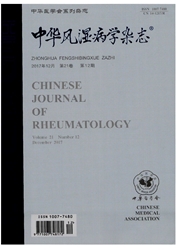

 中文摘要:
中文摘要:
目的:探讨川崎病(KD)患儿急性期Th1/Th2细胞的功能状态及其在KD免疫发病机制中的作用。方法:急性期KD患儿32例,健康对照组16名,KD患儿分别于静脉滴注丙种球蛋白(IVIG)治疗前后直接取血备检,未经任何体外丝裂原刺激培养。采用流式细胞术胞内标记法检测外周血CD4+T细胞白细胞介素(IL)-4和干扰素(IFN)-γ阳性表达率;反转录聚合酶链反应(RT-PCR)及荧光定量PCR检测外周血CD4+T细胞中IFN-γ、IL-2、IL-4、IL-5、IL-6、IL-10、T-bet、GATA-3、SOCS-1和SOCS-3等Th相关的细胞因子及转录因子基因mRNA的表达。结果:①急性期KD患儿Th2细胞比例明显高于健康对照组[(3.40±1.13)%vs(0.48±0.15)%,P〈0.01],Th1细胞比例无明显变化[(11.9±2.0)%vs(12.6±2.3)%,P〉0.05],Th1/Th2比值显著低于健康对照组(6.5±1.4vs33.8±6.2,P〈0.01);②急性期KD患儿外周血CD4+T细胞中Th1细胞因子(IFN-γ、IL-2)和Th2细胞因子(IL-4、IL-5、IL-6和IL-10)基因mRNA表达水平均明显高于健康对照组(P〈0.01),IVIG治疗后部分基因有不同程度的恢复(P〈0.01);③急性期KD患儿CD4+T细胞明显过度表达Th细胞相关的转录因子(T-bet/GATA-3)和调节因子(SOCS-3/SOCS-5)(P〈0.01)。结论:急性期KD患儿Th细胞普遍活化,可能与KD免疫功能紊乱有关。
 英文摘要:
英文摘要:
Objective To investigate the functional status of T helper cells in Kawasaki disease (KD). Methods Thirty-two children with Kawasaki disease and 16 age-matched healthy children were studied. The proportion of type Ⅰ and type Ⅱ helper T cells (Th 1 and Th2) in CD4^+ T cells were analyzed by flow cytometry. Reverse-transcription PCR (RT-PCR) and real-time PCR were used to evaluate the levels of Th associated cytokines,transcriptional factors (IL-2,IL-4,IL-5,IL-6,IL-10), and regulatory factors (IFN-γ,T-bet,GATA-3, SOCS-1 and SOCS3-) as well as their mRNA expression in CD4^+ T cells. Results ①The proportions of Th 1 in CD4^+ T cells in patients with KD was not significantly different from healthy controls [(11.9±2.0)% vs (12.6±2.3)%, P〉0.05), while the proportions of Th2 in CD4^+T cells from patients with KD was higher than that from healthy controls [(3.40±1.13)% vs (0.48±0.15)%, P〈0.01). The value of Th1/Th2 was significantly lower than that of healthy controls (6.4±1.4 vs 33.8±6.2, P〈0.01).②Transcription levels of Th1- (IFN-γ and IL-2) and Th2- (IL-4,IL-5,IL-6 and IL-10) associated cytokines were significantly elevated in acute phase Kawasaki disease (P〈0.01), and were down-regulated after treated with IVIG (P〈0.01). ③Transcription levels of Th-associated transcriptional factors (T-bet/GATA3) and regulatory factors (SOCS-3/SOCS-5) were significantly up-regulated during acute phase of KD (P〈0.01). Conclusion The activation of T helper cells (includ-ing Th1 and Th2 cells) might be correlated with immune aberrance in Kawasaki disease.
 同期刊论文项目
同期刊论文项目
 同项目期刊论文
同项目期刊论文
 期刊信息
期刊信息
